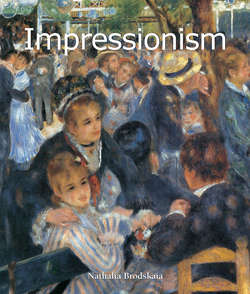Читать книгу Impressionism - Nathalia Brodskaya - Страница 2
На сайте Литреса книга снята с продажи.
Preface
Оглавление1. Claude Monet, Impression, Sunrise, 1873.
Oil on canvas, 48 × 63 cm.
Musée Marmottan, Paris.
Impression: Sunrise was the prescient title of one of Claude Monet’s paintings shown in 1874 in the first exhibition of the Impressionists, or as they called themselves then, the Société anonyme des artistes, peintres, sculpteurs, graveurs (the Anonymous Society of Artist, Painters, Sculptors, and Engravers). Monet painted scenes of his childhood hometown of Le Havre to prepare for the event, eventually selecting his best Havre landscapes for display. Edmond Renoir, journalist brother of Renoir the painter, compiled the catalogue. He criticised Monet for the uniform titles of his works, for the painter had not come up with anything more interesting than View of Le Havre. Among these Havre landscapes was a canvas painted in the early morning depicting a blue fog that seemed to transform the shapes of yachts into ghostly apparitions. The painting also depicted smaller boats gliding over the water in black silhouette, and above the horizon the flat, orange disk of the sun, its first rays casting an orange path across the sea. It was more like a rapid study than a painting, a spontaneous sketch done in oils – what better way to seize the fleeting moment when sea and sky coalesce before the blinding light of day? View of Le Havre was obviously an inappropriate title for this particular painting, as Le Havre was nowhere to be seen. “Write Impression,” Monet told Edmond Renoir, and in that moment began the story of Impressionism.
On 25 April 1874, the art critic Louis Leroy published a satirical piece in the journal Charivari that described a visit to the exhibition by an official artist. As he moves from one painting to the next, the artist slowly goes insane. He criticises the surface of a painting by Camille Pissarro, describing the ploughed field as shavings from an artist’s palette carelessly deposited onto a soiled canvas. When looking at the painting he is unable to tell top from bottom, or one side from the other. He is horrified by Monet’s landscape entitled Boulevard des Capucines. Indeed, in Leroy’s satire, it is Monet’s work that pushes the academician over the edge. Stopping in front of one of the Havre landscapes, he asks what Impression, Sunrise depicts. “Impression, of course,” mutters the academician. “I said so myself, too, because I am so impressed, there must be some impression in here… and what freedom, what technical ease!” At which point he begins to dance a jig in front of the paintings, exclaiming: “Hey! Ho! I’m a walking impression, I’m an avenging palette knife” (Charivari, 25 April 1874). Leroy called his article, “The Exhibition of the Impressionists.” With typical French finesse, he had adroitly coined a new word from the painting’s title, a word so fitting that it was destined to remain forever in the vocabulary of the history of art.
Responding to questions from a journalist in 1880, Monet said: “I’m the one who came up with the word, or who at least, through a painting that I had exhibited, provided some reporter from Le Figaro the opportunity to write that scathing article. It was a big hit, as you know.” (Lionello Venturi, Les Archives de l’impressionnisme, Paris, Durand-Ruel, 1939, vol. 2, p. 340).
